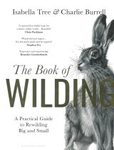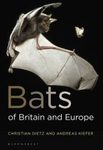By
Leon (NHBS Catalogue Editor)
17 Sep 2019
Written for Hardback

The Scottish wildcat is one of Britain’s most threatened wild mammals. Legend and lore tell of a fierce animal capable of taking down a man if cornered. Once common, only a small remnant population survives in the Highlands of Scotland and now faces the unlikely threat of genetic dilution by hybridisation.
Tracking the Highland Tiger sees nature writer Marianne Taylor go in search of this mysterious cat. But it quickly becomes apparent that the book’s title can be interpreted on several levels.
Tracking the Highland Tiger is a book that works on three interlocking levels. First, there is Taylor’s actual search. In between the factual chapters are reports of trips to the Scottish Highlands, predominantly to Speyside, just north of Cairngorms National Park, and the peninsula of Ardnamurchan in the Western part of Scotland. In beguiling prose, she channels the beauty of the Scottish Highlands as she ventures here several times between 2013 and 2018 in the hope of catching a glimpse of a wild wildcat.
Population estimates for the Scottish wildcat range from as low as 35 to about 2000. But given the remoteness of this area and the elusive and nocturnal habits of this feline, the exact number is anyone’s guess. As Taylor visits these areas, she encounters some of the lucky few who have spotted them. One of her guides in the Speyside area mentions that even for people living and working outdoors in the best possible areas, the likelihood of an encounter is “vanishingly rare”. Similarly, a highly knowledgeable wildlife photographer in Ardnamurchan has managed to snap only a single picture in years. Does Taylor succeed? Well, that would be telling, but her own writing betrays the creeping sensation of it turning into a fool’s errand.
These reports alternate with what is the second level at which this book works, a number of lightly written factual chapters on wildcat biology (for a comprehensive account, see also
The Scottish Wildcat). Taylor covers evolutionary relationships in the cat family; the anatomy, physiology, and behaviour of both domestic cats and the closely related Scottish wildcat; as well as a sketch of its life. As she admits, that last one is necessarily somewhat sketchy and leans heavily on observations of free-living European wildcats and feral and domestic cats.
She furthermore explores the Scottish wildcat in myth and legend, as well as the long and bloody history of human-wildcat interactions. With the advent of agriculture, forests were converted to fields and any creature that threatened crop or livestock was deemed vermin to be eradicated. Larger predators such as lynxes and bears were lost centuries ago. Data on wildcat decline in recent centuries comes from a surprising source: the parish records of bounties paid to hunters (see
Silent Fields). Attitudes towards wild predators have only recently started shifting and conservation efforts to save what is left of the Scottish wildcat are now underway.
This leads into the third, most fascinating, but arguably also the most fraught subject of
Tracking the Highland Tiger. Unwittingly or not, Taylor’s search for the Scottish wildcat is prominently a search for its identity. Because what, really, is the Scottish wildcat? Not even taxonomists agree amongst each other, many considering it a subspecies,
grampia, of the European wildcat
Felis silvestris, others saying it is a full-fledged species,
Felis grampia, while the IUCN SSC Cat Specialist Group does not recognize
grampia at all. And though the wildcat genome has been sequenced, we do not have an objective scale to decide how much difference in DNA is enough to recognize it as a species, subspecies, or maybe just a distinct subpopulation.
Taylor admits that “wildcats
do look a lot like pet tabbies”, which is not helping conservation efforts. Additionally, the Scottish wildcat and our domestic cat are fully genetically compatible (disastrously so, she writes) and can interbreed. With an estimated 1.2 to 1.3 million pet and feral cats in Scotland, the biggest threat is that of genetic dilution through hybridisation. The sad and uncomfortable truth is that it is exceedingly unlikely that there are pure Scottish wildcats left, with all existing individuals carrying a certain fraction of domestic cat genes.
Now, the whole species concept discussion will give any biologist a headache (see also
The Species Problem and
Species Concepts in Biology), and here you can exactly see why. What level of genetic purity is sufficient to say a wildcat is still a wildcat? Is it worth conserving a genetically already compromised taxon of dubious status? And should we really be trying to swim against the current, expending great effort to artificially maintain a situation of genetic segregation and stasis? I know that some pragmatic voices argue that these are losing battles not worth fighting (see
Inheritors of the Earth), but Taylor is not one of them.
There is more to the Scottish wildcat than its genetic identity, argues Taylor. Fittingly, she sees out the book with the ongoing efforts of two conservation projects. Scottish Wildcat Action focuses on surveys and, foremost, captive breeding. By using coat patterns and measures of genetic purity (the baseline being the wildcat genome obtained from museum specimens), they hope to dilute domestic cat DNA in captive wildcat populations, with an ultimate aim of reintroduction. Wildcat Haven (a name bestowed by Mike Tomkies after
his book by the same name) focuses on in situ conservation, establishing conservation areas free of feral and hybrid cats. Both encourage pet owners to neuter their cats and are seeking to deal with the existing feral cat population through trap-neuter-release approaches.
Tracking the Highland Tiger is an eye-opening look at this little-known cat that engages the reader on several levels and is an easy, quick read. Taylor does much to clarify the messy reality of its status as a species, arguing in favour of its conservation with equal measures of passion and reason. Given that even many Scottish people are unfamiliar with their wildcat, this book ought to be read widely.




































